Ceca air dryer
Four fuel systems are available for use in Cell 3. Three of these
supply fuel at ambient temperature but the other, described in para 18, supplies fuel heated by mineral oil at temperatures up to
250°C at 15 to 165 lb/ln2, the maximum flow being 40,000 lb/h. Two of the normal fuel systems give maximum flows
of 6,000 and 12,000 gal/h at 2,000 lb/in2, while the third supplies 4,200 gal/h at 2,000 lb/in2, the two
larger systems are operated in a spill arrangement which enables acceleration work to be carried out at substantially steady supply
pressures.
Engine operation during transient acceleration cycles can be measured in addition to the usual performance
observations under steady state conditions and for this purpose engien test information is normally fed through an on-line
SDS9300 computer with a PDP7 unit for data acquisition in support. As an alternative, experimental information can be recorded
by back-up photographic methods. Paragraph 23 lists the available instrumentation in greater detal.
15. Cell 3 Air Heating Plant
The Cell 3 heater is shown in Figure 59 and consists of a vertical
oil fired cylindrical furnace, 80 ft hight and 20 ft diameter, with the walls lined with tubes through which the
air supply is passed. Heat is tranferred to the air tubes by radiation from the 12 oil burners which are fitted on
the floor of the furnace and arranged to fire upwards. The air inlet mainfold is mounted at the top and the
outlet manifold is situated under the furnace floor, thus the air flow direction is downwards. The heater is arranged
to be manually operated during the starting cycle and switched to automatic control once the desired operating
temperature has been reached. The heater performance data is given in Table X.
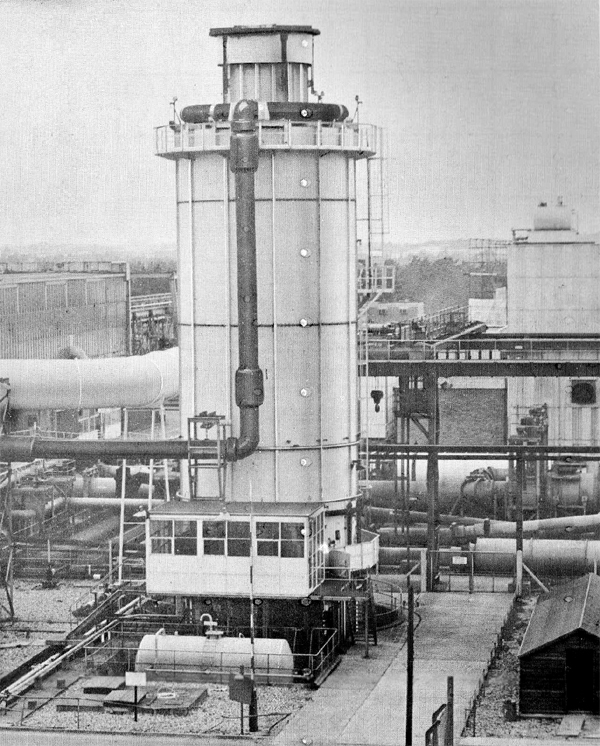
|
|
Fig. 59 Cell 3 air heater
|
Table X
Air Heater Performance Data
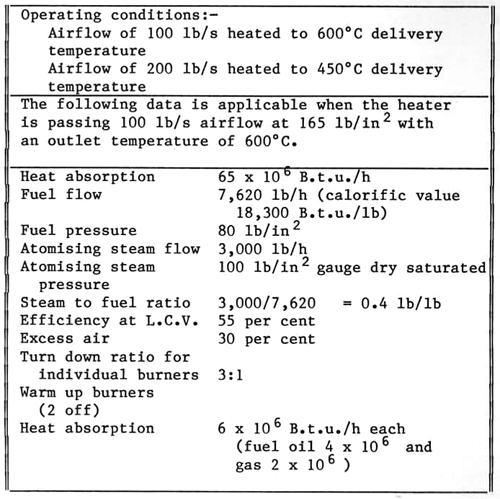
The air is routed from the heater to the Cell, as shown in Figure 55, by way of stainless steel
ducting. Air leaving the heater can be controlled over the range 300°C to 600°C as dictated by the test in progress
and final temperature control is obtained by mixing heated and unheated G.E.C. air in the mixing sphere.
16. Cell 3 Cold Air Plant
The cold air plant works in conjunction with a precooler and pressure dryer to reduce ice formation; temperatures down to
-70°C can be obtained by use of a cold air expansion turbine which is designed to give a maximum flow of 100 lb/s.
Temperatures between ambient and -70°C can be achieved by mixing warm air from the G.E.C. machines with that from the
cold air plant in the mixing chamber which has special large valves to meter the supply. When necessary, ambient air can be
drawn into the chamber and blended with the cold supply; the circuits which make this possible are shown in Figure 55.
Figure 60 shows the temperature/air weight flow relationship obtained from the cold air plant and the
cold air expansion turbine alternator is illustrated in Figure 61. The power generated by the air expansion turbine is
absorbed by an alternator of five megawatt output and the electrical current is returned to the N.G.T.E.
grid supply.
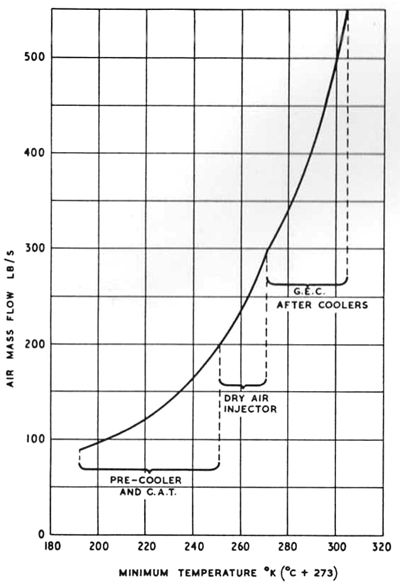
|
|
Fig. 60 Cell 3 cold air plant temperature characteristics
|
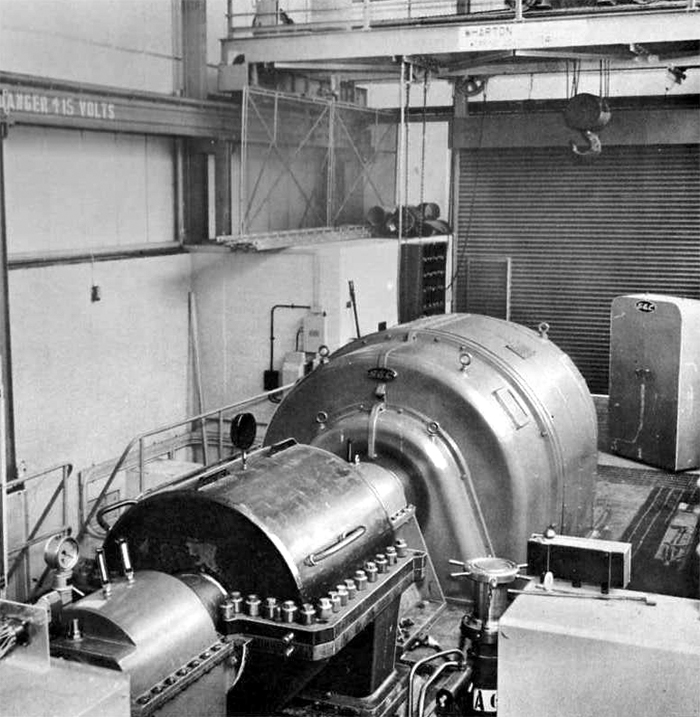
|
|
Fig. 61 Cell 3 cold air plant
|
17. Cell 3 Ice-making Facilities
Ice particles in air-breathing engine intakes can have a serious effect on performance. Consequently,
two special ice-making plants are installed in association with Cell 3
so that all altitude effects can be investigated. The two plants are:
- The ice crystal plant, and
- The super-cooled water droplet plant.
The former has the capacity to produce ice blocks which are cut into small particles and injected into the engine under test.
Ice blocks can be produced at the rate of one ton every twenty-four hours and facilities exist for storing four to five tons
of ice for an indefinite period. The plant produces particles between 500 and 4,000 microns in size. The particle injection
rate is variable between 5½ and 152 lb/min.
Alternatively, super-cooled water droplet plant can produce a spray of super-cooled water droplets within the
engine inlet duct. These will freeze out on contact with the cold engine inlet surfaces and so build up ice formations.
The basic air and distilled water system can deal with a water injection rate of up to 600 gal/h but some operational
difficulties have been experienced with the spray nozzle atomisers. if a water droplet size of 20 microns is expected,
the total flow is limited to 148 gal/h; this may be increased to 185 gal/h if the droplet size is expanded to
30 microns. The water concentration in the engine intake depends on the volume flow.
18. Cell 3 Hot Fuel Supply
To simulate engine operating conditions at high speed in test plant at ground level it has become necessary
to preheat engine fuels to correspond with flight conditions where elevated fuel temperature occur when fuel is used
to cool the aircraft structure and skin.
A plant, located near Cell 3, has been installed to
provide a service to heat fuel up to 250°C and pipelines have been laid to service Cell 3.
Mineral oil, heated in two oil fired heater units to temperatures up to 300°C, is passed through coils
in a 9,000 gallon capacity dwell tank to heat the engine fuel up to 100°C. The engine fuel is pumped from this dwell
tank to Cell 3 via heat exchangers in which the fuel is given a second stage
of heating by the mineral oil to raise the fuel temperature to the required level. The system supplies an engine under
test with up to 40,000 lb/h of fuel at temperatures up to 250°C and pressures up to 160 lb/in2. Higher
fuel flows up to 60,000 lb/h are possible but at correspondingly lower temperatures. A spill system, incorporating
a dump cooler, is used and transient flow conditions are possible with substantially steady inlet pressures.
The circuits used for fuel at temperatures above 100°C, including the heat exchangers, are
constructed from 18/8 stainless steel.
19. Cell 3 West
To ground test, under simulated flight conditions, the new technology fan engines such as the Rolls-Royce RB207 and RB211,
a new engine chamber of a very large diameter has been constructed at the west end of the
Cell 3 suction manifold. The triple shaft design and high
by-pass ratio of these engines create a test demand which absorbs the whole of the present N.G.T.E.
exhauster resources, namely all eight G.E.C. and the Parsons
No. 9 and
No 10 machines. (See Figure 5).
A cold air plant capable of cooling an air capacity corresponding to the maximum engine requirement
has been built as part of the Cell 3 West scheme. The cooler, described later,
uses a 30 per cent aqueous ammonia solution precooled to -50°C in a cold store which is reactivated between individual
cold test runs. At maximum design conditions there is sufficient 'cold' stored to permit the RB211 engine to run for
approximately 30 minutes but with less arduous air flow and temperature demands the test duration can be proportionately longer.
The engine chamber can be run both with and without cold air; in the latter case air can be drawn either direct from atmosphere
through an intake silencer or through the cooler with no coolant circulation. In all cases the engine is directly
coupled to the intake so that all tests are of the connected type.
Provision has been made on the engine chamber for a pressure connection from the
G.E.C. machines in order than the chamber can be converted to a blown test bed when required at a future date.
Cell 3 West assists the commerical exploitation
of large fan engine design by enabling full flow cold air tests to be undertaken at flight operating
altitudes. The performance of Cell 3 West
operating with the RB211 engine is shown in Figure 62.
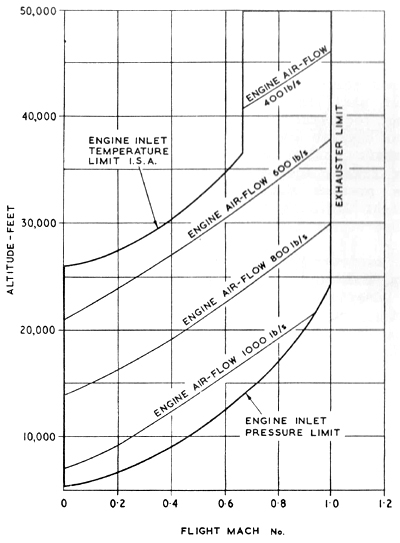
|
|
Fig. 62. Cell 3 West typical test envelope with Rolls Royce RB211 engine
|
Figure 63 shows Cell 3 West generally,
whilst Figure 64 shows the front of the Cell with the end dome and inlet ducting removed to expose
the inside compartment and a RB211 engine installation. The removal of the complete front end dome permits
easy access for the engine at the time of installation.
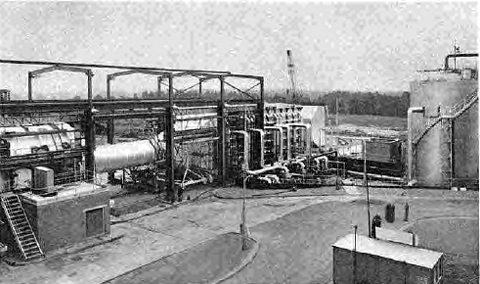
|
|
Fig. 63 General view of Cell 3 West
|
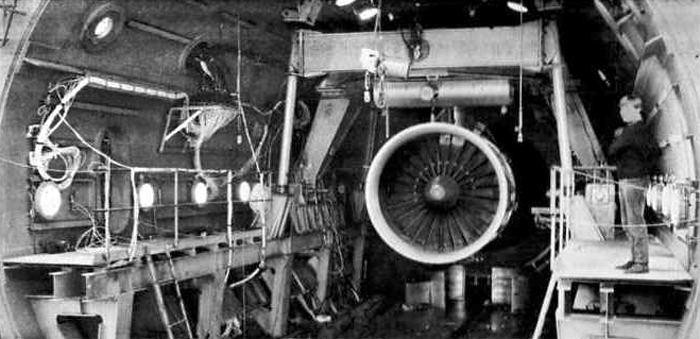
|
|
Fig. 64 View of Cell 3 West engine chamber with the front dome removed
|
The Cell 3 West engine chamber is 25 ft diameter
and 40 ft long and an extension of the Cell 3 exhaust manifold, which is
15 ft diameter, is directly coupled to the exhaust end of the cell. Unlike
Cell 3,
Cell 3 West
has been built at ground level unlike Cell 3 and consequently the exhaust
manifold passes through two cascaded right angle bends in order to accommodate the height difference. The
Cell 3 West exhaust manifold is fitted with bulkhead doors which are shut
in non-testing periods if the suction mains are in use for
Cells 3 and
Cell 4. The atmospheric to exhaust mainfold pressure difference helps to
keep a pressure tight seal. Figure 65 shows the arrangement of the engine chamber relative to the eight G.E.C. suction mains
and it should be noted that a similar isolating bulkhead is located on the Cell 3
end of the manifold so that installation and modification work can proceed in Cell 3
whilst Cell 3 West is operational.

|
|
Fig. 65 Cell 3 West Test Area
|
To maximise exhauster performance, an internal exhaust gas diffuser is sited in the parallel
section of the exhaust duct immediately downstream of the engine exhaust nozzle. The vertical exhaust duct from
Cell 3 West which joins the exhaust manifold is fitted with direct
injection water cooling sprays and an inbleed valve for altitude trimming purposes.
It is possible to measure engine thrust in Cell 3 West
as the engine mounting includes special features to permit the movements required for thrust and drag measurements.
The engine is clamped to a support frame which is itself supported from flexible rods attached to the roof of
the cell. The mounting permits the small deflections which are needed to measure thrust and draft on
Davey United Ltd. load cells. The engine installation includes an automatic-connect bulkhead arrangement
so that a large proportion of engine instrumentation and other service supplies to the engine are automatically
made when the engine is lifted into its finally installed position. This arrangement is identical to sea
level installations at Rolls-Royce, so that it is possible to make speedy interchange of engines which
are sea level tested at Derby and altitude tested at Pyestock. In the past, the installation work
associated with engine instrumentation has frequently delayed engine testing programmes.
The inlet ducting which connects with the cooler is 77 ft long, of which 43.5 ft is external
to the cell and the rest internal. This ducting includes an air flow measuring section as well as air
straightening gauzes which improve the air distribution at the engine entry plane.
Both steady state and transient instrumentation is available; test information is normally
fed through the on-line SDS 9300 computer with the PDP7 data acquisition unit in support. Certain back-up
information by photograph recording is alos provided. Altogether the instrument installation is able to provide
300 pressures and 200 temperature points for steady state conditions and 30 channels of U.V. and 28 channels
of magnetic tape for transient conditions. A local control room adjacent to the Cell is used to operate
the test plant, the engine and its associated auxiliaries. Further details of the instrumentation service is
given in paragraph 23.
The fuel system is tapped off from that used in
Cell 3 and is of similar design. A spill return line is situated close
to the engine supply tee-off and fuel in excess of that required by the engine is returned to the plant
fuel supply tank. This arrangement eliminates the need to accelerate large quantities of fuel through
the long supply pipework during engine transients.
The spray cooling water system operates on a recirculatory basis with a make up supply
to replace water evaporated into the air stream. Two banks of spray nozzles are provided and each is fitted
with on-off and flow control valves. The quantity of water injected is carefully controlled to ensure than just enouhg
is sprayed into the gas stream to maintain an acceptable gas temperature at inlet to the exhausters.
20. Cell 3 Cold Air Plant
The air intake cooler consists of 33 modules built in three rows of eleven modules. Each module
has 18,500 ft run of 1 in o.d. x 16 B.G. mild steel pipe of plain section. The tubes are galvanised externally
and the module headers are interconnected toegether in such a way as would allow the cooler modules to be removed
for emergency repairs. Altogether, when all modules are interconnected, the cooler has a total length of
61 ft 5 in with frontal dimensions of 27 ft x 29.5 ft. The assembly is mounted on its own wheeled carriage and
the cooler can be wheeled out of position along its own track if required. Figure 66 shows the cooler assembly
cold store tanks and refrigeration plant.
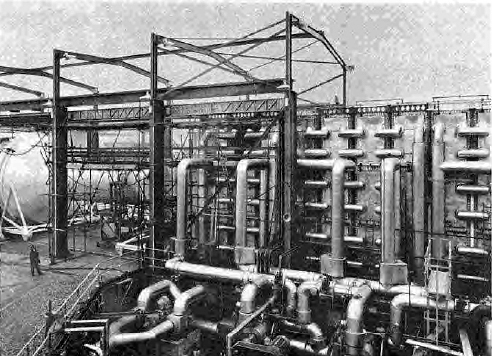
|
|
Fig. 66. View of Cell 3 West cooler assembly
|
The cold store of aqueious ammonia is reactivated in twenty-four hours using the
refrigeration plant which is sited adjacent to the cooler unit.
This refrigeration plant includes the necessary condensers, evaporators, pumps, etc.,
and is of conventional design rated at 2.25 million B.t.u./h.
Coolant from the pre-cooled store of aqueous ammonia is circulated through the cooler which is divided into
three stages for this purpose. Each stage of the cooler has an independent flow control system and coolant is recirculated wherever
possible to ensure maximum use of the "cold". Eventually the coolant is returned to the cold store where an interface, formed between
the "warm" and "cold" coolant, travels down the tank as testing proceeds. The duration of a run is dependent on the
rate at which coolant is drawn from the tank and the position of the interface. Under some circumstances the length of test
run may be limited by the falling off in heat transfer coefficient due to ice building up on the outside of the cooler tubes.
The cooler has been designed to give thirty minutes running time at -37°C with an air
throughput of 800 lb/s assuming air inlet conditions of 7.3°C dry bulb temperature and 100% relative
humidity. Operating times and temperatures at other air flows and inlet conditions have yet to be established
but an approximation of the performance expected based on inlet conditions of 0°C and 18°C with
relative humidities of 100 per cent and 50 per cent respectively is given in Figure 67.
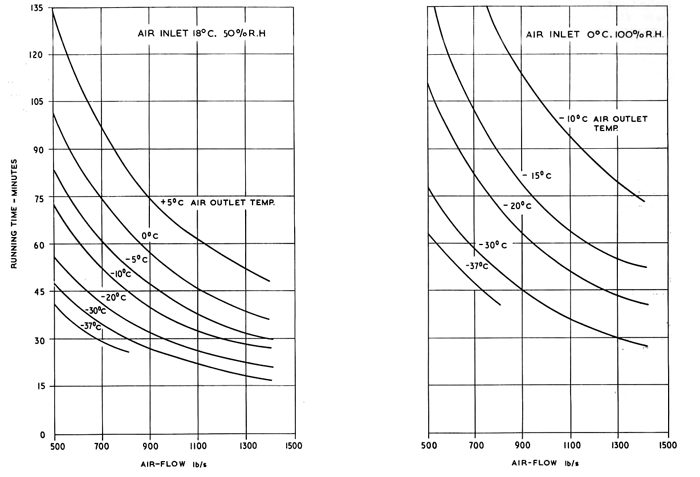
|
|
Fig. 67 Cell 3 West estimated performance of air inlet cooler using one cold store tank
|
21. Cell 4 Test Plant
When gas turbine engines are chosen to operate in supersonic aircraft, there is a need to test the engine
in close association with the aircraft air intake system which is designed to reduce the air speed at the
compressor face to an acceptance velocity thus converting the forward ram velocity into high engine
intake pressure with a resultant bonus in power plant performance.
Although the engine an intake problems arising in supersonic flight are inter-related, a true
simulation of all relevant factors is only achieved if full-scale free jets are possible;
Cell 4 provides this capability for engines such as the Rolls-Royce
Olympus 593 engine for Concorde and it is possible to test this engine and similar power plants with their intakes
and control systems under high speed flight conditions. The Cell provides a means of observing on the ground the
interaction of the intake and engine at changing altitude, Mach number and incidence. The performance range of
Cell 4 is given in Figure 68. Figures 69 and 70 show
actual views of the Cell 4 plant and associated machinery and
some idea is obtained of the size and engineering complexity of full-scale free jet tests. In addition to
testing in the free jet supersonic mode, the cell has also been used for subsonic free jet testing of the engine
and intake. Also, by removing the blowing nozzle, connected testing of engines with reheat has been successfully
undertaken with an experimental thrust measurement system installed in the engine mounting frame.
Figure 71 shows the Rolls-Royce Olympus 593 engine installed in the Cell 4
engine chamber; this view is taken from the engine tailpipe end with the propelling nozzle in the immediate
foreground, looking forward to the bulkhead which divides the engine chamber from the intake
working section. Figure 72 shows the air circuit diagram for Cell 4
which is designed to handle a maximum flow equivalent to two G.E.C. sets, i.e. 400 lb/s, under pressure
conditions, with the capability of increasing this flow to 600 lb/s at lower pressures by the use of
an injector system.
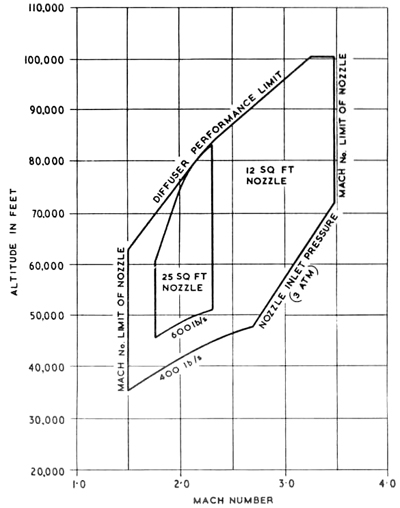
|
|
Fig. 68 Performance envelope for Cell 4 plant
|
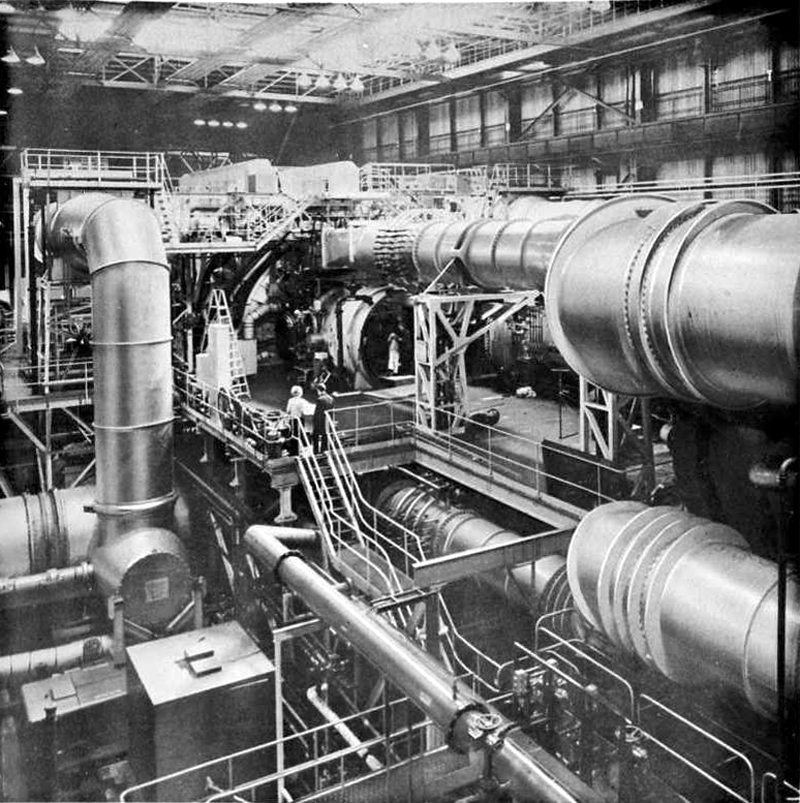
|
|
Fig. 69 General view of Cell 4
|
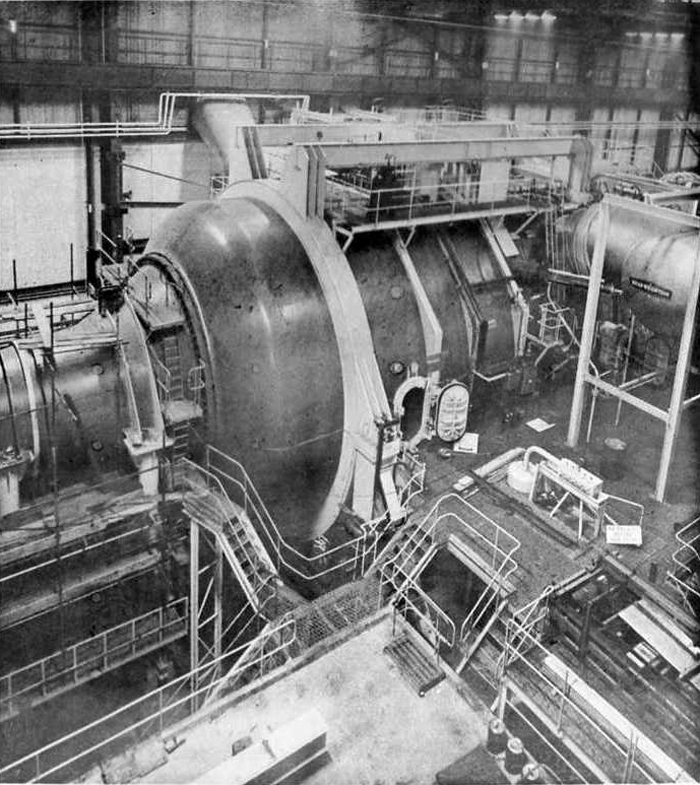
|
|
Fig. 70. Cell 4 plenum chamber
|
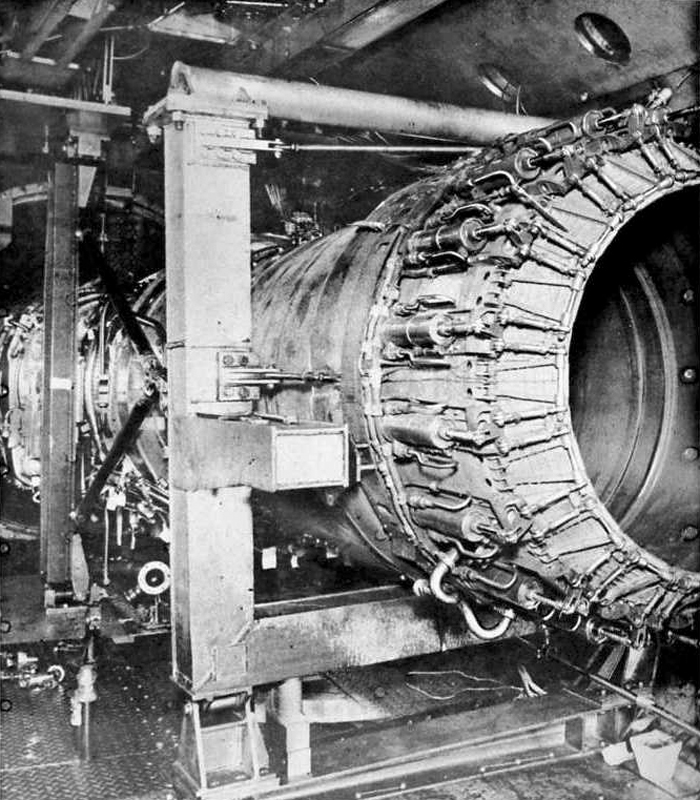
|
|
Fig. 71. Rolls-Royce Olympus 593 for Concorde installed in Cell 4 engine capsule
|
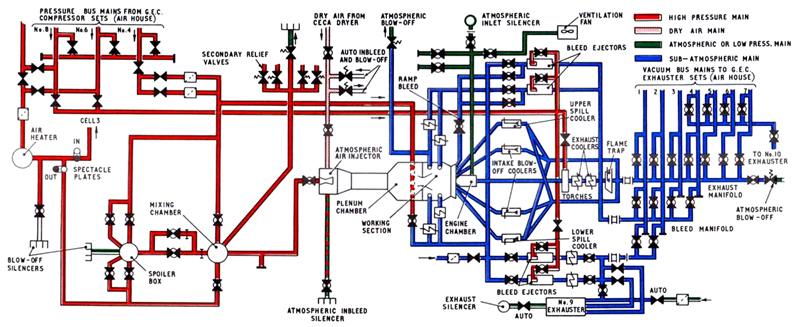
|
|
Fig. 72. Cell 4 process air diagram
|
The total air mass flow can be provided as dry air from the
Ceca air dryer which is described in para 11. Normally, the
Cell air supply maximum inlet pressure does not exceed three atmospheres absolute and the temperature ranges
from 70°C to 470°C using the air heater described in para 15. The Cell is built parallel to
Cell 3; the relative position of these plants is shown in
Figure 6 which also shows the inter-connecting ducting with the G.E.C. and
No. 9 and
No. 10 exhausters.
Flight speed is simulated by a supersonic blowing nozzle which has an adjustable throat and
wall contour to provide variable Mach number operation. This nozzle is mounted on a universal carriage which enables
aircraft pitch and yaw conditions to be simulated up to angles of +/- 10° at rates of up to 20° and
10° per second respectively. The total weight of the nozzle and moving carriage assembly is approximately
75 tons. Figure 73 shows the carriage assembly with the 25 square foot nozzle in position viewed through the plenum
chamber with the 20 foot diameter inlet cone removed.
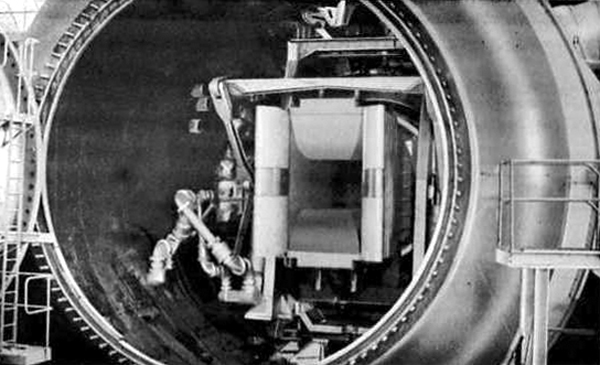
|
|
Fig. 73 Cell 4 carriage assembly and supersonic blowing nozzle
|
To match engine performance more closely two variable nozzles are
available; the first is 12 sq ft in area, giving a Mach number ange of 1.5 to 3.5 while the second
is 25 sq ft in area giving a Mach number range of 1.7 to 2.5.
A general cross sectional view of Cell 4
is shown in Figure 74. The diagram illustrates how the aircraft intake is mounted in the working
section immediately downstream of the blowing nozzle with the engine coupled behind.

|
|
Fig. 74 Cross section of Cell 4 altitude test plant
|
Spill diffusers, which are shown more clearly in Figure 75, are mounted above and
below the intake and are used to obtain altitude conditions in the working section by converting low
pressure, high velocity air from the nozzle into higher pressure, low velocity air. As the downstream end of
the spill diffusers are connected to exhausters it can be seen that the diffusers are a means of aiding
the exhausters to obtain altitude.
Changes in altitude are obtained by varying the geometry of the
diffuser.
Better use of the installed exhauster is obtained by sucking away the low energy
air issuing from the supersonic blowing nozzle, normally about four per cent of the nozzle mass flow.
This process is termed "working section bleed" and is performed by the
No. 9 machine referred to in para 5.
As stated above, Figure 75 shows diagrammatically the flow paths in the supersonic nozzle,
spill diffuser and engine intake. The geometry of the Concorde intake makes it necessary to provide
additional ductwork to accommodate the "ramp bleed" and "dump door" flows which are an
essential feature of the Concorde aircraft power plant. The ramp bleed flow is piped away from
the upper part of the intake and returned to the working section to be sucked away by
No. 9 exhauster machine. The dump door flow is sucked
away through one of the two permanent plant blow-off ducts to join the main exhaust system
further downstream.
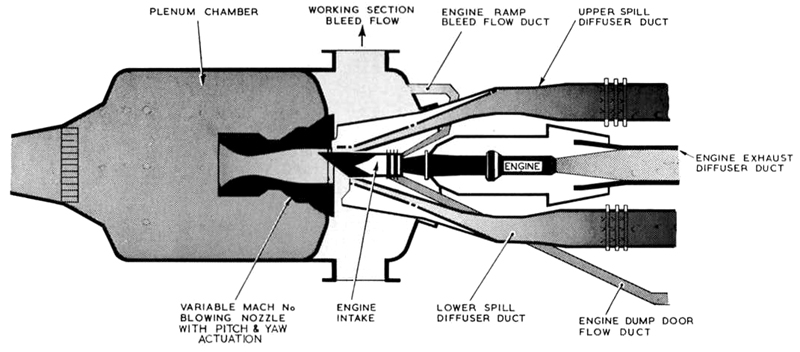
|
|
Fig. 75 Cross section of Cell 4 intake assembly, and flow ducts for
Rolls-Royce Olympus 593
|
As in all altitude cells, the heat exchanger needed to cool the engine exhaust
is a major plant item. The Cell 4 gas cooler has two
stages, the first stage cooler is shown pictorially in Figure 76 which also shows the six
flame torches that ignite any unburnt fuel in the engine exhaust so that explosion risks are
eliminated. The exhaust gases leave the water-cooled diffuser duct at temperatures up to
1,700°C to enter the first stage cooler where they are cooled to 1,000°C by a novel
gasover-tube matrix; a water flow of 620,000 gal/h is circulated through the matrix. In the second
stage cooler, where the gases pass through the tubes in a conventional manner, the temperature
of the gases is reduced to 150°C. This second stage also has a water circulation of 620,000
gal/h. Additionally, the flow from direct injection water sprays is used as evaporative cooling
to reduce the gas temperature further to 50°C, this latter temperature being the maximum for
the inlet flow to the G.E.C. exahusters. The excess water from all the direct injection sprays
drains from the air ductwork into a 40 ft deep barometric well. The well is divided into two sections.
Clean water is drained into one section from which it is pumped back to the water storage ponds, and
water that has been contaminated by the exhaust gases is drained into the second section from which it
is pumped into the site sooty water plant described in Section 5. The total
recirculating flow of all cooling water systems in Cell 4 under
hot running conditions is 2.5x106 gal/h. Losses up to 170,000 gal/h through evaporations,
leakages and contamination are incurred.
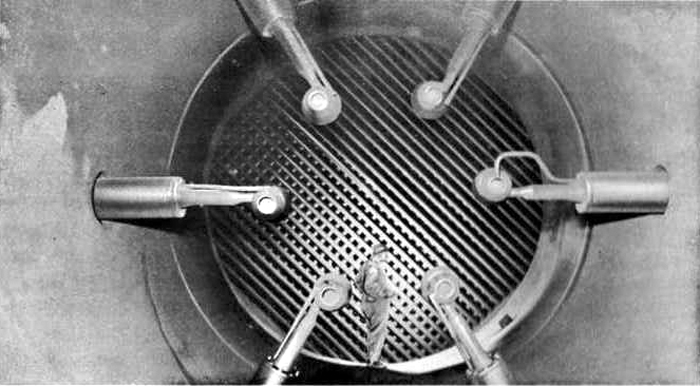
|
|
Fig. 76 Cell 4 first stage gas cooler matrix
|
The exhaust cooling system is manufactured entirely from conventional ferrous materials.
During non-running periods corrosion is arrested by filling the system with a solution of sodium suplhite and
sodium hydroxide.
Altogether, Cell 4 has a total length of
approximately 400 ft of which the 30 ft diameter inlet plenum chamber with its blowing nozzle contributes
36 ft and the working section 10.5 ft. The engine chamber itself has a diameter of 10 ft and a length of
16 ft and the exhaust diffuser 55 ft; the first and second stage coolers have diameters of 26 ft and 18 ft
respectively, the total length of the two stages is 160 ft, whilst 105 ft of ducting at the rear end
of the cell accommodates the seven G.E.C. exhauser connections.
The fuel system is teed off that serving Cell 3
and described in para 3.3. As both cells do not run at the same time, no inconvenience is suffered by
having a common system. The fuel flow rates are 100 gal/min and 200 gal/min for engine and reheat systems
respectively. Normally, the engine flight fuel pump is used on engines installed in
Cell 4, therefore, the plant fuel system provides fuel to the
engine low pressure pump at a set pressure of 25 lb/in2; however, if needed, fuel at pressures
up to 100 lb/in2 can be supplied.

|
|
Fig. 77 Cell 4 control room with test in progress
|
Figure 77 shows the main Control Room for Cell 4 with a test in
progress. All test results are fed direct to the SDS 9300 computer which has a PDP7 computer in support.
The engine stedy state pressures and temperatures are processed beforehand in a digital data aquisition unit
so that the information can be handled by the computers. Back-up photographic recording equipment is
also available.
The instrumentation installation permits 300 pressure and 200 temperature points to be
measured during steady state processing. Twenty-eight channels of magnetic tape, 36 channels of U.V. recording
and digital counters for engine speed and fuel flow are available for transient conditions. Further details
of the instrumentation service are listed more comprehensively in para. 23.
22. Sea-Level Engine Testing Plant (The Glen Test House)
The facilities required for testing gas turbine engines under sea-level
conditions are not so complicated as those needed for simulated altitude flight conditions which
have already been described; however, userful and much less expensive development work can
be conducted on sea-level static beds. Figures 78 and 79 show views of the N.G.T.E. plant built
on the New Site and known as the Glen Test House.
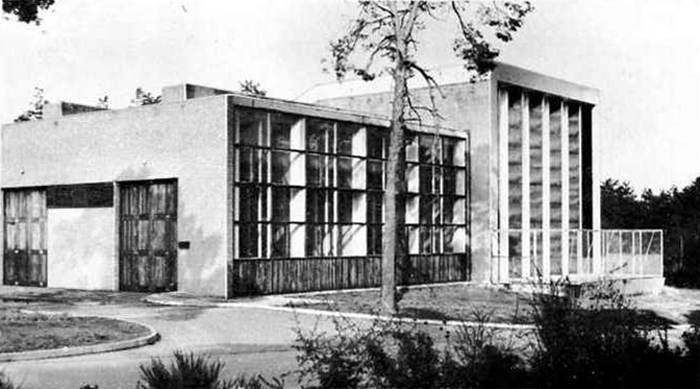
|
|
Fig. 78 External view of the 'Glen' test house
|
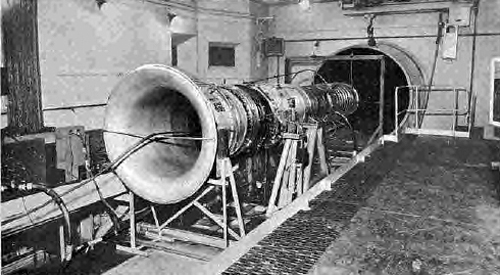
|
|
Fig. 79 Aircraft gas turbine installed in the 'Glen' test bed
|
The plant was originally installed for engines not greater than 250 lb/s air mass flow
and 28,000 lb of thrust; but already engines of 320 lb/s and 35,000 lb thrust such as the
Olympus 302 engine have been tested in the Glen Test House. Modifications are now in hand to
increase the capacity still further so that the bed can accommodate the Olympus 593 for Concorde.
The test plant will shortly have an ability to accommodate 435 lb/s engiens giving
34,500 lb of thrust. An important part of the installation is the exhaust cooling and silencing
system which was planned to keep the noise levels below 105 decibels at a radius of 250 ft from
the test bed. The design allows engines to be tested with exhaust reheat systems in which the exit
temperature may be as high as 2000°K; the engine throughput is diluted with a larger volume of
induced air, 2:1 ratio approximately, which servers to cool the hot exhaust gases. The total silencer
weight flow is therefore approximately 1,250 lb/s. Water cooling sprays have been added at the entrance
of the exhaust tunnel to augment the exhaust cooling system.
There are two separate fuel systems, one for the engine supply and the
other for reheat; in total, 12,000 gal/h is available at the engine test bed of which 2,000 gal/h, at
pressures from 20-50 lb/in2, is available in the engine supply and 10,000 gal/h, at
pressures from 100 to 1,000 lb/in2 in the reheat.
Figure 80 shows a plan view of the test facility which includes a fitting-out area
in which engines can be installed on the test frames with their experimental instrumentation equipment so
that actual installation time in the test bed can be kept to a minium.
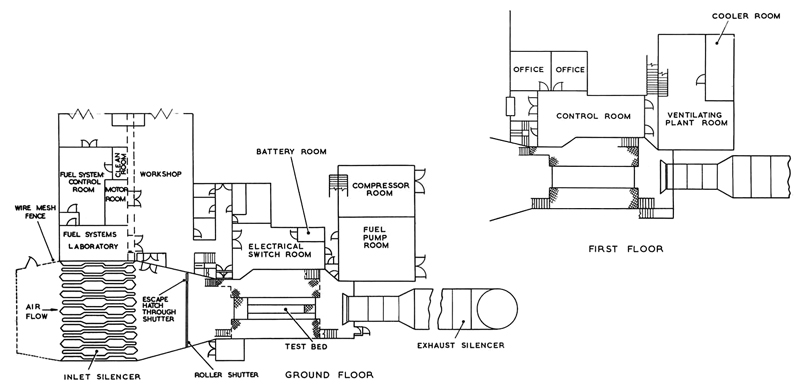
|
|
Fig. 80. Plan layout of the 'Glen' test house
|
23. Instrumentation in the Engine Test Facility
Two groups of instruments measure engine test data, the first group give a direct display
in the cell control room of engine and plant behaviour and are used to set-up and control the test in progress. The
second group are installed to monitor more concisely the engine and plant parameters which are used to
calculate test performance data. This latter group of instruments relay their information to a SDS9300 computer
which records and calculates test data according to prearranged software programmes.
Generally, the driving instruments terminate at visual indicators on the engine driver's panel but those observations
also required for performance calculations have circuits teed together so that readings are also routed to the computer.
The driving instruments comprise manometers and gauges for pressure measurements, differential gauges for air and water flows,
and thermocouples transmitting to visual pyrometers and chart recorders for temperature measurement; an accuracy of +/- 2 per
cent of full scale deflection is normally acceptable for the engine control room instruments. The important air inlet and
cell working pressures related to forward speed and altitude conditions are measures by bellows type maonmeters based on
the R.A.E. 'Midwood' design and which have a high resolution over a wide working range. Increasingly, automatic control of plant
is being introduced whenever operating costs or manpower can be reduced.
Permanent instrument pipelines and circuits originating at junction boards in the engine control
compartment connects with the data acquisition system whilst short flexible temporary lines are used to connect this
compartment with the sensing points in the engine; this system permits changes to be made in the instrumentation
schedules for individual tests. Comprehensive scheduling nomenclature exists so that the permanent lines can be quickly
identified and coupled to the individual engine sensing points.
The engine instrumentation installed enables both steady state and transient measurements to be made.
The parameters that may be measured are temperature, pressure, speed, fuel flow, thrust, angles and areas. Table XI
shows the range of instrumentation available to each cell.
TABLE XI
INSTRUMENTATION CHANNELS AVAILABLE FOR E.T.F. TEST CELLS
STEADY STATE DIGITAL SYSTEM
TEMPERATURE
PRESSURE
THRUST
MONITOR
ANGLES AND AREAS
SPEEDS, FUEL FLOWS AND FREQUENCY |
100
100
1
1
UP TO 100
TOTAL OF 6 |
200
200
1
-
UP TO 200
TOTAL OF 6 |
200
300
1
-
UP TO 200
TOTAL OF 6 |
200
300
-
-
UP TO 200
TOTAL OF 6 |
200
300
-
-
UP TO 200
TOTAL OF 6 |
-
-
-
-
USE TEMPERATURE CHANNELS
- |
ANALOGUE VISUAL SYSTEMS
CHART RECORDER
THRUST
MONITOR
TEMP,PRESS,SPEED FUEL FLOW
ULTRA-VIOLET RECORDER
TEMP,PRESS,SPEED FUEL FLOW,ANGLE,AREAS
DIAL INDICATION
SPEED FUEL FLOW
DECIMAL DIGITAL DISPLAY
SPEED
FUEL GALS GONE |
-
1
1
9
-
36
-
3
-
2 |
-
1
-
-
-
36
-
4
-
2 |
-
-
-
-
-
36
-
2
-
2 |
-
-
-
-
-
30
-
3
-
2 |
-
-
-
-
-
30
-
3
-
2 |
-
-
-
TOTAL OF 9
-
FURTHER 36 IN COMP ROOM
-
FREQ DC CONVERTERS
-
VENNER COUNTERS |
ANALOGUE MAGNETIC TAPE SYSTEM
TEMP,PRESS,SPEED,FUEL FLOW,ANGLES,AREAS |
-
28 |
-
28 |
-
28 |
-
28 |
-
28 |
-
ARRANGED AS DESIRED |
TELEVISION LINK
CHANNELS |
-
- |
-
1 |
-
4 |
-
3 |
-
3 |
-
- |
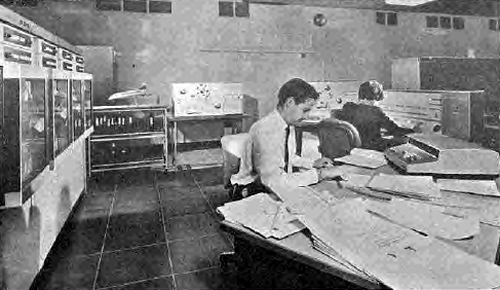
|
|
Fig. 81. N.G.T.E. computer installation.
|
Figure 81 shows the main computer installation being operated during a
test run. In steady state performance work, minimum accuracies of 0.25 per cent of full scale deflection
are required, but in fact values of 0.1 per cent are frequently achieved. The arrangement of the steady
state instrumentation is shown diagrammatically in Figure 82. The various measurements are fed to
an electronic analogue/digital converter via a switching system and amplifier. The 17 digit output of the
converted is then fed to the computer room.
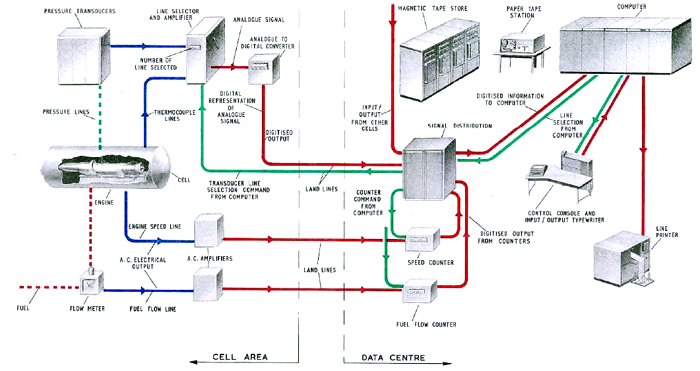
|
|
Fig. 82. Steady state instrumentation arrangement.
|
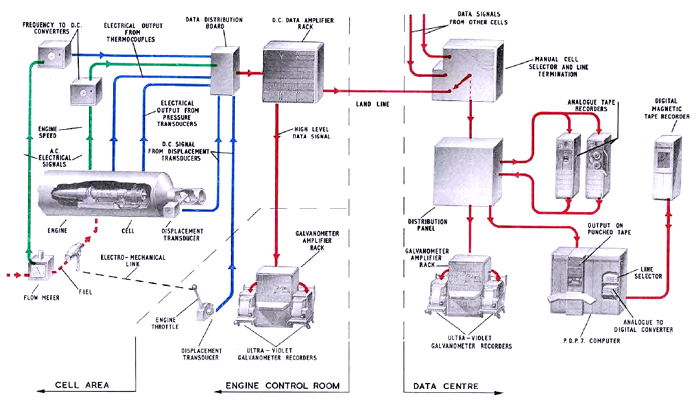
|
|
Fig. 83. Transient instrumentation arrangement.
|
The computer itself is programmed to work ON-LINE and individual points are evaluated immediately.
The computer has stored within itelf all necessary calibrations and one of its tasks after the input information is collected
is to convert this data into engineering units, e.g. lb/in2, degress absolute, gal/min, etc.
After meaning or averaging, selected data may be used to compute performance parameters ready for plotting
the engine performance curves.
The maximum speed of data acquisition for steady state work is 100 points a second.
The transient instrumentation system is shown in Figure 83. DC signals from the various sensors and
transducers are fed into a data distribution board from which ultra violet galvanometer recorders, analogue tape
recorders and a computer are fed in parallel. Magnetic tape recording of the transient conditions is produced in the computer
room and can be used as an input to the computer when required. By using the UV recording units, on-line visual examination
may be made both in the control room and in the data centre. In addition, other visual systems such as chart recorders
and decimal displays are installed.
A back-up photographic installation is available in all cells using manometers and pyrometers to record
pressures and temperatures in an emergency or when checks on the normal instrument systems are desirable.
© Procurement Executive, Ministry Of Defence

